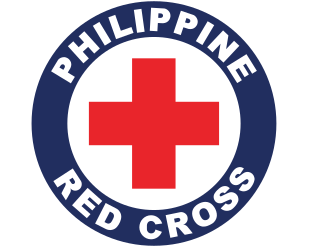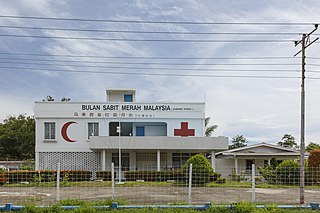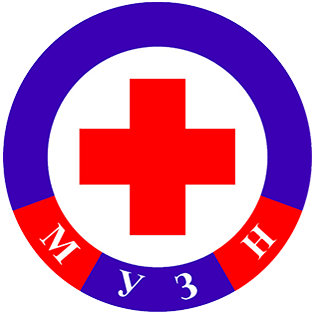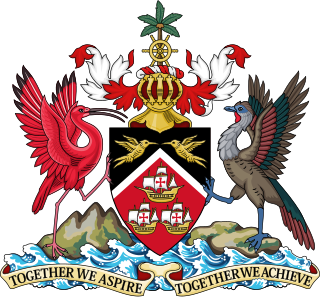External links
- Official Web Site
- Official Red Cross International Web Site
- Trinidad and Tobago Red Cross Society Profile
| | This Trinidad and Tobago article is a stub. You can help Wikipedia by expanding it. |
| Founded | 12 July 1939 |
|---|---|
| Type | Non-governmental organization |
| Focus | Humanitarian and Disaster Management |
| Location |
|
Area served | Trinidad and Tobago |
| Website | www |
The Trinidad and Tobago Red Cross Society (TTRCS) was founded on 12 July 1939 as a Branch of the British Red Cross Society. It has its headquarters in Port of Spain, with branches in the North and South of the island of Trinidad and one branch on the island of Tobago. Following the attainment of independence in 1962, the TTRCS became an Independent Society by Act No. 15 of 1963. On August 8, 1963, the TTRCS became part of the International Committee of the Red Cross and the International Federation of Red Cross and Red Crescent Societies. The Constitution of the Trinidad and Tobago Red Cross Society is based on the Geneva Conventions of 1949 and their additional Protocols of 1977 and the Fundamental Principles of the Red Cross Red Crescent Movement which are:
The TTRCS is made up of several departments with programmes grouped into six core areas:
The Trinidad & Tobago Red Cross Society (TTRCS) is an auxiliary in the humanitarian field to the Government of the Republic of Trinidad & Tobago.
Governance
The Trinidad and Tobago Red Cross is controlled and administered by a General Council which represents the Society as a whole. The General Council has thirty-six members, some appointed and some elected. 18 are members of the Executive Committee, which governs the Trinidad and Tobago Red Cross Society.

The International Red Cross and Red Crescent Movement is an international humanitarian movement with approximately 97 million volunteers, members and staff worldwide, which was founded to protect human life and health, to ensure respect for all human beings, and to prevent and alleviate human suffering. Within it there are three distinct organizations that are legally independent from each other, but are united within the movement through common basic principles, objectives, symbols, statutes and governing organisations.

The Australian Red Cross, formally the Australian Red Cross Society, is a humanitarian aid and community services charity in Australia. Tracing its history back to 1923 and being incorporated by royal charter in 1941, the Australian Red Cross Society is the national member of the Federation of Red Cross and Red Crescent Societies and part of the International Red Cross Movement. The Australian Red Cross is guided by the Fundamental Principles of the International Red Cross and Red Crescent Movement and as such is a non-religious, neutral, impartial and independent humanitarian organisation.

The Italian Red Cross is the Italian national Red Cross society. The Italian Red Cross was one of the original founding members of the International Committee of the Red Cross in 1919.
The Cyprus Red Cross Society (CRCS) is the only Red Cross society in Cyprus recognised by the International Red Cross and Red Crescent Movement. The Headquarters of the Society are located in Nicosia.

The Philippine Red Cross abbreviated as (PRC) is a member of the International Red Cross and Red Crescent Movement.

The International Committee of the Red Cross is a humanitarian organization based in Geneva, Switzerland. State parties (signatories) to the Geneva Convention of 1949 and its Additional Protocols of 1977 and 2005 have given the ICRC a mandate to protect victims of international and internal armed conflicts. Such victims include war wounded persons, prisoners, refugees, civilians, and other non-combatants.

The Malaysian Red Crescent Society (MRCS), is a voluntary humanitarian organization that seeks to promote humanitarian values, as well as provide service and public education in disaster management, as well as healthcare in the community. It is part of the International Red Cross and Red Crescent Movement.
There are a number of meanings for the term humanitarian. Here humanitarian pertains to the practice of saving lives and alleviating suffering. It is usually related to emergency response whether in the case of a natural disaster or a man-made disaster such as war or other armed conflict. Humanitarian principles govern the way humanitarian response is carried out.

The International Federation of Red Cross and Red Crescent Societies (IFRC) is a worldwide humanitarian aid organization that reaches 160 million people each year through its 192-member National Societies. It acts before, during and after disasters and health emergencies to meet the needs and improve the lives of vulnerable people. It does so with impartiality as to nationality, race, gender, religious beliefs, class and political opinions.
The Red Cross Society of Bosnia and Herzegovina(hereinafter: RCS BiH) is a component of the International Red Cross and Red Crescent Movement. It was recognized by the International Committee of the Red Cross (ICRC) on 8 May 2001 and admitted as a member to the International Federation of Red Cross and Red Crescent Societies (IFRC) on 7 November 2001.
The Sudanese Red Crescent (SRC) is the biggest and most decentralized and widespread humanitarian organization operating in Sudan. The society developed out of the Sudan branch of the British Red Cross Society and was established in 1956. Upon Sudan's independence in March 1956 received official recognition as an independent National Society following the Sudanese Council of Ministers decree No. 869. The National Society covers nearly the entire country with 15 State branches and several sub-branches/units in the provinces/localities and administrative units, with a nationwide community-based network of 35,000 active volunteers and another 300,000 who can be deployed as need arises. It has well-established working relations with public authorities at federal, state and local levels, and good partnership and collaboration with Movement partners and UN specialized agencies and national and international NGOs working in Sudan.

The Mongolian Red Cross Society (MRCS) is the largest humanitarian organization in Mongolia. It was established in 1939 as part of the International Red Cross and Red Crescent Movement and is an auxiliary to the Mongolian Government.

In September 2004, Hurricane Ivan caused significant effects in the Lesser Antilles and South America, including 44 deaths and over $1 billion in damage (2004 USD), primarily in Grenada where it was considered the worst hurricane in nearly 50 years. Hurricane Ivan developed from a tropical wave on September 2 and rapidly intensified to become a major hurricane, passing through the southern Lesser Antilles on September 7 with winds of 125 mph (205 km/h). At the time, its typical storm force winds extended outward up to 160 miles (260 km) with hurricane-force winds outward to 70 miles (110 km), and the northern portion of the eye passed over Grenada.
The Rome Consensus for a Humanitarian Drug Policy is a framework for dialogue and cooperation that commits 114 National Societies of Red Cross and Red Crescent from Africa, Asia, the Americas and Europe to promote and implement humanitarian approaches to drug policy. The Rome Consensus aims at raising the profile of drug policy to the forefront of social concerns, hinging formulation and implementation of drug control on public health concerns.

Myanmar Red Cross Society (MRCS) was founded in 1937 and it was earlier called Burma Red Cross. It has its headquarters in Yangon.

The Albanian Red Cross, or ARC, is the national society member of the International Federation of Red Cross and Red Crescent Societies for Albania. The oldest humanitarian organization in Albania, it was founded on October 4, 1921, and was officially recognized by the Red Cross and Red Crescent Movement in 1923. Its headquarters are located in the Albanian capital of Tirana, and its 39 branches provide humanitarian assistance across the country in accordance with the Fundamental Principles.

The Indian Red Cross Society (IRCS) is a voluntary humanitarian organization to protect human life and health based in India. It is part of the International Red Cross and Red Crescent Movement, and so shares the Fundamental Principles of the International Red Cross and Red Crescent Movement. The society's mission is providing relief in times of disasters/emergencies and promoting health & care of vulnerable people and communities. It has a network of over 700 branches throughout India. The Society uses the Red Cross as an emblem in common with other international Red Cross societies. Volunteering has been at the very heart of the Indian Red Cross Society since its inception in 1920, with the Society having Youth and Junior volunteering programmes. The Society is closely associated with the St John Ambulance in India.
The Maldivian Red Crescent (MRC) is an independent, volunteer, non-profit, humanitarian organization established in the Maldives by virture of the Maldivian Red Crescent Act Law No: 7/2009

The Queen of Trinidad and Tobago was the head of state from independence in 1962 to abolition of the monarchy in 1976. The monarch's constitutional roles were delegated to a governor-general, who acted on the advice of government ministers.